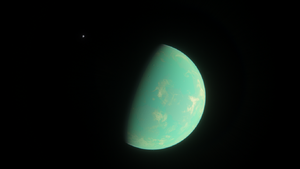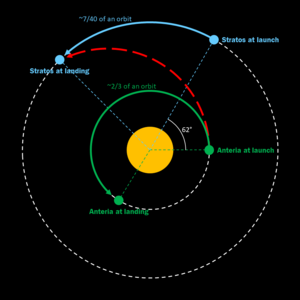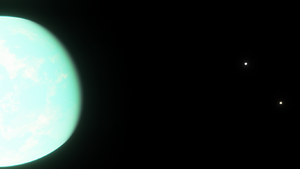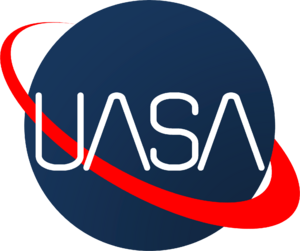Human mission to Stratos
The idea of sending a manned mission to Stratos has been first proposed in a legitimate science study in late 1940's, but has not come to fruition yet. Currently, landing and establishing a Stratoshian colony has been stated among the goals of national space programs of San Calia and the Inner Sekidean Union. Given the difficulty of such programme, it is assumed, that a manned mission is not possible before the 2030 orbital launch window, allowing for a manned landing by October 2030.
Travel to Stratos
Launch windows
Due to the orbits of Anteria and Stratos, a launch window opens approximately once every 3 years and 3 months, with the transfer between the two planets taking approximately 8 months.
| Launch window | Optimal flight duration | Probes sent | ||
|---|---|---|---|---|
| Start | Optimal | End | ||
| 5 August 1964 | 10 August 1964 | 16 August 1964 | ~240 days | — |
| 13 December 1965 | 18 December 1965 | 24 December 1965 | ~240 days | — |
| 21 May 1967 | 26 May 1967 | 1 June 1967 | ~220 days | — |
| 30 August 1968 | 5 September 1968 | 11 September 1968 | ~250 days | — |
| 7 January 1970 | 12 January 1970 | 18 January 1970 | ~230 days | — |
| 17 May 1971 | 22 May 1971 | 28 May 1971 | ~210 days | — |
| 24 September 1972 | 29 September 1972 | 5 September 1972 | ~250 days | — |
| 1 February 1974 | 6 February 1974 | 12 February 1974 | ~220 days | — |
| 11 June 1975 | 16 June 1975 | 22 June 1975 | ~220 days | — |
| 19 October 1976 | 24 October 1976 | 30 October 1976 | ~260 days | — |
| 26 February 1978 | 3 March 1978 | 9 March 1978 | ~220 days | — |
| 6 July 1979 | 11 July 1979 | 17 July 1979 | ~230 days | — |
| 13 November 1980 | 18 November 1980 | 24 November 1980 | ~250 days | — |
| 23 March 1982 | 28 March 1982 | 3 April 1982 | ~210 days | — |
| 31 July 1983 | 5 August 1983 | 11 August 1983 | ~240 days | |
| 8 December 1984 | 13 December 1984 | 19 December 1984 | ~240 days | — |
| 17 April 1986 | 22 April 1986 | 28 April 1986 | ~200 days | |
| 25 August 1987 | 30 August 1987 | 5 September 1987 | ~250 days | — |
| 2 January 1989 | 7 January 1989 | 13 January 1989 | ~230 days | — |
| 12 May 1990 | 17 May 1990 | 23 May 1990 | ~210 days | — |
| 19 September 1991 | 24 September 1991 | 30 September 1991 | ~250 days | — |
| 27 January 1993 | 1 February 1993 | 7 February 1993 | ~230 days | |
| 6 June 1994 | 11 June 1994 | 17 June 1994 | ~220 days | |
| 14 October 1995 | 19 October 1995 | 25 October 1995 | ~260 days | — |
| 21 February 1997 | 26 February 1997 | 4 March 1997 | ~220 days | — |
| 1 April 1998 | 6 April 1998 | 12 April 1998 | ~200 days | |
| 8 November 1999 | 13 November 1999 | 19 November 1999 | ~250 days | — |
| 18 March 2001 | 23 March 2001 | 29 March 2001 | ~210 days | — |
| 26 July 2002 | 31 July 2002 | 6 August 2002 | ~240 days | — |
| 3 December 2003 | 8 December 2003 | 14 December 2003 | ~240 days | |
| 12 April 2005 | 17 April 2005 | 23 April 2005 | ~200 days | — |
| 13 September 2007 | 18 September 2007 | 24 September 2007 | ~250 days | — |
| 6 May 2009 | 11 May 2009 | 17 May 2009 | ~210 days | — |
| 14 September 2010 | 19 September 2010 | 25 September 2010 | ~250 days | — |
| 22 January 2012 | 27 January 2012 | 2 February 2012 | ~230 days | — |
| 31 May 2013 | 5 June 2013 | 11 June 2013 | ~220 days | |
| 9 October 2014 | 14 October 2014 | 20 October 2014 | ~260 days | — |
| 16 February 2016 | 21 February 2016 | 27 February 2016 | ~220 days | |
| 25 June 2017 | 30 June 2017 | 6 July 2017 | ~230 days | — |
| 3 November 2018 | 8 November 2018 | 14 November 2018 | ~250 days | — |
| 12 March 2020 | 17 March 2020 | 23 March 2020 | ~210 days | |
| 20 July 2021 | 25 July 2021 | 31 July 2021 | ~230 days | — |
| 27 November 2022 | 2 December 2022 | 8 December 2022 | ~250 days | — |
| 6 April 2024 | 11 April 2024 | 17 April 2024 | ~200 days | — |
| 14 August 2025 | 19 August 2025 | 25 August 2025 | ~240 days | — |
| 22 December 2026 | 27 December 2026 | 2 January 2027 | ~240 days | — |
| 1 May 2028 | 6 May 2028 | 12 May 2028 | ~210 days | — |
| 8 September 2029 | 13 September 2029 | 19 September 2029 | ~250 days | — |
| 16 January 2031 | 21 January 2031 | 27 January 2031 | ~230 days | — |
| 26 May 2032 | 31 May 2032 | 6 June 2032 | ~220 days | — |
| 3 October 2033 | 8 October 2033 | 14 October 2033 | ~260 days | — |
| 10 February 2035 | 15 February 2035 | 21 February 2035 | ~220 days | — |
| 20 June 2036 | 25 June 2036 | 1 July 2036 | ~230 days | — |
| 28 October 2037 | 4 November 2037 | 10 November 2037 | ~260 days | — |
| 7 March 2039 | 12 March 2039 | 18 March 2039 | ~210 days | — |
| 15 July 2040 | 20 July 2040 | 26 July 2040 | ~230 days | — |
| 22 November 2041 | 27 November 2041 | 3 December 2041 | ~250 days | — |
| 1 April 2043 | 6 April 2043 | 12 April 2043 | ~200 days | — |
| 9 August 2044 | 14 August 2044 | 20 August 2044 | ~240 days | — |
| 17 December 2045 | 22 December 2045 | 28 December 2045 | ~240 days | — |
| 26 April 2047 | 1 May 2047 | 7 May 2047 | ~210 days | — |
| 3 September 2048 | 8 September 2048 | 14 September 2048 | ~250 days | — |
| 11 January 2050 | 16 January 2050 | 22 January 2050 | ~230 days | — |
Presupply missions
Due to the climate and atmospheric conditions on Stratos, it is assumed that at least two launch windows before the mission have to be dedicated for presupply mission, to establish a functional satellite net for better weather measurement and picking multiple landing places, as due to the changing weather conditions and lakes of liquid hydrocarbons, it is a high risk to establish a base on a location, where flooding is possible.
First orbital window of any presupply to a manned mission would require a set of weather satellites to form a net around Stratos, which, at the time, does not exist, in order to measure the surface and weather patterns and choose multiple sufficient landing sites.
Second orbital window of any presupply to a manned mission would require the more robust parts of the equipment, such as the habitat, or the SAV (Stratos Ascent Vehicle) to arrive before the crew along with supplies and research equipment, that could not be delivered with the main cargo and a manned vessel.
Surface supplying option
The most discussed option of any manned mission to Stratos is landing the second presupply mission on the picked landing site before the arrival of the manned crew. This would ensure, that mission control, as well as the crew, would have certainty, that all the equipment landed safely and would allow for a replacement in case landing failed.
Dowsides of this option are, that any equipment left on surface would be forced to endure the harsh climate of the planet for a total of three years before the manned crew arrives, with a possibility of a vital failure of any of the many required systems for manned landing.
One way to solve this problem could be by choosing a landing site, that is shielded from two or more sides by terrain, creating a natural barrier from the strong winds. This would, however, create a far bigger risk during the landing procedures, risking the landing equipment to crash into a harsh terrain even if they miss by a couple hundred meters.
Other way to solve the weather problem is by keeping the equipment in orbit for a longer time and proceed with landing only shortly before the manned mission is to depart. This, in theory, reduces to the risks weather poses onto the equipment, but due to the maneuverability problems, would require highly unstable orbits to be used, risking a fatal malfunction in navigation, which could result in one or more of the essential probes burning in the thick atmosphere.
Orbital supplying option
An alternative to a surface option, it is possible to keep most of the presupply equipment in a stable orbit around Stratos and allow any future manned crew to manually land the equipment, reducing the risk of fatal failure during landing.
However, if any of the landing procedures fail, the mission would have to be cancelled without a chance of replacement of more vital parts of the equipment. Another problem of this plan is, that if either the lander or the ship are using methane engines, it would require time for the equipment to produce methane from ethane, which may in case of bad weather delay the return of the crew and may push the crew to miss an orbital launch window on return back, effectively stranding them on Stratos for three more year, which would put massive requirements of supply missions.
Satellite option
Probably the most ambitious option of all four. This option includes the idea of landing a part of the equipment on one or more of the Stratos' natural satellites, particularily Loftuslo thanks to its 1:2 orbital resonance and almost circular orbit. This proposal is similar to the orbital option, however, has multiple advantages. If all supplies are landed on one of the natural satellites, there is no risk of their orbital navigation failing or them losing course and burning in the atmosphere. Thanks to its low gravity, it would require only a little fuel to take off the equipment off Loftuslo, allowing for a "safe storage" space.
Problems with this plane include all the problems with methane refueling the orbital plan has to deal with, however, also includes the limitation of landing, as any launch from any of the satellites would cover only the areas close to the planet's equator. Besides of this, there is also a risk of a mission failure due to a fatal error in landing the equipment to the surface of the planet or during a possible retrieval by the manned crew.
No supplying option
Third option, probably the most dangerous of them all, is to merge the second presupply mission with the main mission. This option, although having the shortest timetable and therefore allowing for the biggest flexibility and giving the country an upper hand when it comes to a hypothetical space race, is always combining the dangers of both previous options.
This mission would, due to refuelling and orbital dynamics and landing all the equipment, require more time than the orbital window allows, effectively forcing the crew to stay up to three years on Stratos, putting a massive pressure on supplies and fuel, as there would be no window open for that time. This in turn exponentially increases the size of a spacecraft needed for a human habitation, requiring large volume of space for both additional supplies, fuel and those parts of the equipment, that would have been sent in the second presupply mission.
Because of those and many more problems, the UASA discourages from this mission, as the chances of failure are bigger than the previous two and the possibility of any error being fatal to the mission is also bigger.
Landing on Stratos
In the 2008 UASA meeting, engineer Meƌar Ȝamo, member of the director board of ZASO, held a speech about the possibilites of manned landing on Stratos, listing a total of four possible ways to navigate a manned craft down to the surface, each having their own problems. This craft, referred to as SDV (Stratos Descent Vehicle), is considered to have already entered at an angle, where it will not burn and is between 70 and 50 kilometers above the surface. Besides, it is considered to be carrying only the crew and few supplies, with other supply missions having already landed.
Parachute landing
Landing using one or more parachutes is probably the safest and also simplest solutions for a manned landing, however, due to the weather conditions on the surface, it is a real possiblity, that an unpredictable wind in the lower parts of the stratosphere could carry the craft far from its intended location, as any navigation using parachutes could be highly problematic in the thick atmosphere of Stratos.
Engine landing
Second option on how to land is to keep the acceleration up to the mid of troposphere, where the landing engines would pick up and start to slow down the craft until a touchdown at landing. This option eliminates the problem with the wind, but also requires a lot of fuel and runs the risk of ignition of the atmosphere around, if there is an oxygen leak in the landing gear, which in turn may cause an unpredicted explosion below the spacecraft.
Airbaloon landing
Third option outlined in the speech was the indirect landing using hot airballoons. Given the properties of the Stratoshan atmosphere, it being cold and three times thicker than the one of Anteria, it would be sufficient to simply use the air inside of the spacecraft to slow down the descent and slowly navigate the area, if the spacecraft is constructed in a way to not weight the air inside down or has airballoon tanks. Using this, the aircraft would slow down enough for it to possibly navigate to the landing spot chosen against the winds using special propellers. The dangers of this option include the risk of prolonged exposer to a flexible material of the airballoons to the cold and wet atmosphere of Stratos, which could in turn cause a burst in the surface and a collapse of the spacecraft.
Shuttle landing
The last option discussed was the option of using a spaceshuttle to land on a picked place on the surface. This shuttle would descend to the upper troposphere and then navigate to the place dedicated as the landing spot, after which it would use smaller engines at the bottom of the plane to land. This, thanks to the different properties of the Stratoshan atmosphere, would make maneuverability much more difficult because of the increased air drag. This option would also require a landing space with flat terrain, in turn being viable for only the orbital and satellite supply missions.
Leaving Stratos
Compared to landing on the Stratos, leaving it is more difficult. The same factors which helped during the landing are playing against any crew trying to leave Stratos. Main problems include thick atmosphere and gravity similar to that one of Anteria.
Single-stage rocket
Probably the simplest solution to the problem, the idea is to use a single-stage SAV, which carries all the fuel and material to the orbit. The main problem is, that any rocket used in this way is unusable again, as it is too worn down by the atmosphere and maneuvering.
Two-stage rocket
Second solution includes an idea of a two-stage rocket, with the first stage bringing the craft to the place where the atmosphere is thin enough for orbit to be established and the second stage bringing the craft to a rendezvous with the spaceship. The general concept is, that the lower stage could later descend back to the landing pad and be refueled and checked, possibly allowing reusing of the rocket. The upper stage then could be used as a SDV.
Indirect launch
Probably the most complicated solution, that is feasible only in case of a permanent colony, this concept includes a rig that uses airballoons to carry the SAV multiple tens of kilometers into the atmosphere, allowing a smaller single-stage rocket to separate from the rig and navigate to the orbiting spacecraft. The rig can eventually return back to the ground by letting the air in the baloons cool. The main problem is, that any SAV in this system has to be relatively light, forcing multiple launches for any mission change.
Challenges
Distance
One of the most obvious problems is the distance between the two planets, considering the reality, that Anteria's distance from Stratos is anywhere between 1.3 and 3.5 astronomical units. Even in case the two planets are currently in a position where there is a launch window, any supplies from Anteria will approach Stratos in 8 months. Outside of the launch window, supply mission may take up to 2 years. A hypothetical slingshot maneuver around Slahonus may be possible for a smaller cargo, however, its application to a larger mission, which a supply flight may be, is highly problematic.
Communication
Communication delay between Stratos and Anteria may range anywhere between 10 minutes and 49 seconds (shortest delay) and 29 minutes 7 seconds (longest delay) one way (that is 21 min 38 sec to 58 min 14 sec round-trip delay. Any communication between the two planets would inevitabely take too much time for effective help to be offered, meaning that the crew on Stratos has to be trained to solve problems on their own and quickly, as help from Anteria is highly ineffective and in the best case would get to Stratos in 8 months.
Medical
Although Stratos has gravity similar to the one of Anteria (9.300 m/s2 compared to the 9.807 m/s2, that is about 95% of Anterian gravity), its atmospheric pressure is three times the one on Anteria (about similar to the depth of 20 meters below water). Although the habitats would be pressurized to the pressure survivable by humans, any activity on the surface would require specially reinforced spacesuits helping to hold the proper posture, to prevent disfigurements of the body. This, in turn, would require special powering and would limit mobility of the crew, considering the pressure.
Thanks to the strong magnetic field of Stratos, radiation on the surface is not a problem, however, missions on orbit may be in problem due to the increased exposure.
Enviromental
The biggest problem is the presence of liquid hydrocarbons, as some may react with the softer mechanics of the base and spacesuits, considering the danger of strong winds and unpredicatble weather. Outside of this, the changing layout of the lakes and rivers may create danger of flooding in the less mountainous areas.
Considering the temperature, another problem would be thermal isolation of the base and spacesuits, considering the fact, that thanks to the atmospheric pressure, regular spacesuit would be losing heat relatively quickly.
Long-term presence
The idea of a long-term presence has been floated around, especially in science-fiction, for a long time. Any possible human habitation requires presence of ice, from which air and drinking water can be produced, and access to energy.
Water
Ice, from which drinking water could be melted and which could be broken into oxygen for breathing and hydrogen for fuel and hypothetical nuclear fusion, can be found on the surface of Stratos in abundance. There are patches of liquid water near active vulcanoes, but it is considered unfeasible to construct a base there, as the tectonic instability of those areas is considered to be a negative, that outweighs the possibility of avoiding the process of melting the ice.
Energy
There are three feasible energy sources on Stratos - carbohydrates, atmosphere and thermal. Besides those, energy resources, that may be used, include nuclear, which needs fuel from Anteria. Solar energy, due to the thick gravity and distance from the Sun, is not feasible on Stratos.
Thermal
While thermal energy is probably the most secure way to produce energy from local resources, it also requires a choice in locality near an active vulcano. Due to the plate tectonics and the need for the base to be located partially underground, it is considered to be of a significant danger, to rely on thermal energy, or, more broadly, to build a base close to an edge of a tectonic plate.
Atmosphere
Atmosphere, which often produces strong winds, may be used by building wind turbines or other wind power harvesting. This energy is probably one of the most reliable sources, that is not geographically limited to a few areas. While the winds themselves are too strong for convential wind turbines constructed on Anteria, it is possible to construct a wind turbine, that is able to work under the conditions of high pressure and strong winds.
The biggest problem with this project is the maintenance of those wind turbines, as the construction, no matter how robust, would eventually get worn down and active maintenance of those wind turbines would be necessary on a monthly basis.
Carbohydrates
One of the most unique resources, that may be found on the planet, is in liquid carbohydrates. While the major flows, the size of rivers, may be used to generate hydropower, due to the unpredictable changes in flow volume and direction, it is not feasible in most localities, outside of the deltas leading to lakes.
Other source, that stems from the carbohydrates, is the chemical energy, that may be produced in exothermic reactions (such as the combustion of a hydrocarbon fuel, which turns methane and oxygen into water and carbon dioxide, while producing heat (CH4 + 2O2 → CO2 + 2H2O).
Protection from nature
Due to the weather conditions, any habitat would have to be mostly underground, both picking the heat from below the ground and avoiding losing this heat by exposed surface to the atmosphere. Besides this, it would be reasonable for any base to be located in a naturally sheltered area, shielded from the worst of the wings by terrain.
Possible landing sites
As of November 2024, no space agency announced their planned landing sites.
Programs
Multiple space agencies announced programs to set a manned crew onto Stratos, although none of the current space agencies has set it as its main focus.
| Mission | Organization | Planned supply | Planned landing | Possible date |
|---|---|---|---|---|
| No name announced | SCSP | ? | ? | September 2029 orbital window |
| Polus program | SPASEK | ? | ? | September 2029 orbital window |






